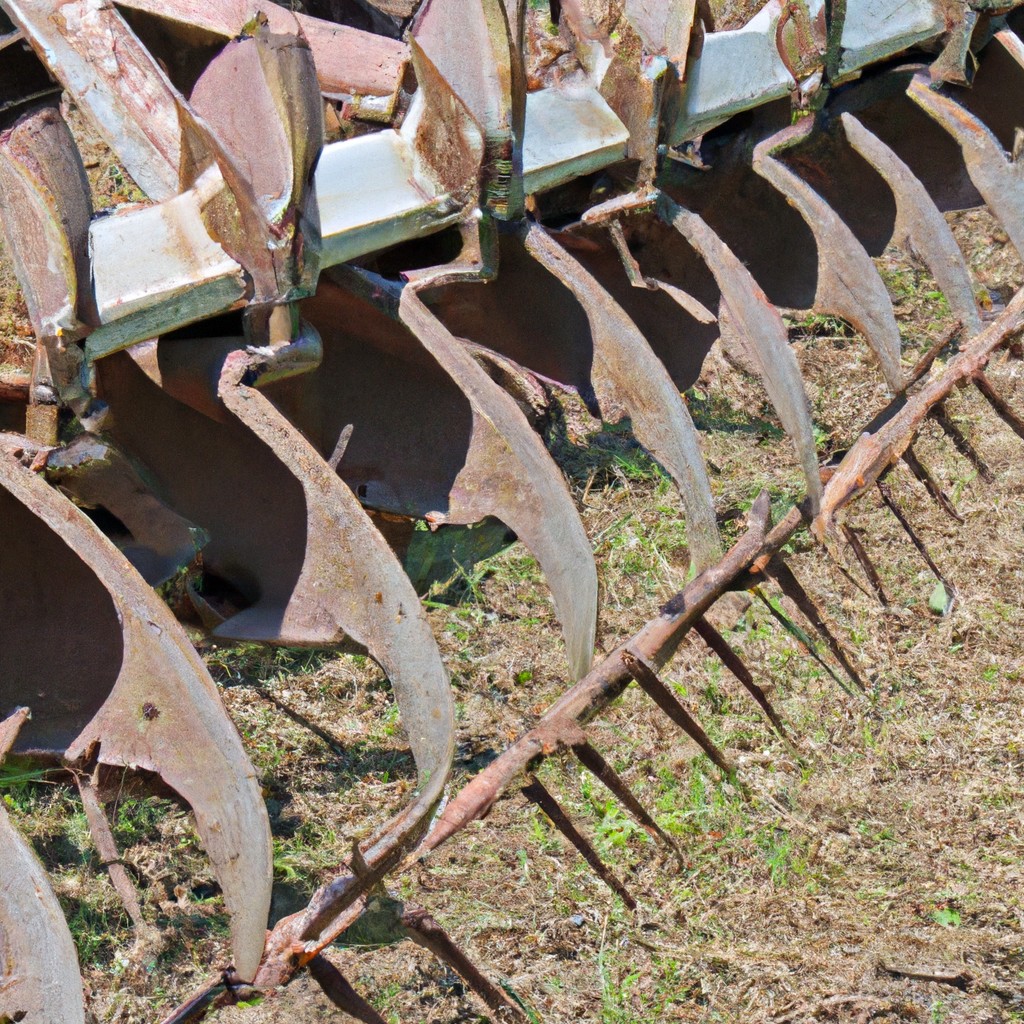In this article, you’ll learn about the different types of farming equipment and their uses in modern agriculture.
Look Inside:
Types of Farm Equipment and Their Uses

Diving right into the agrarian toolkit, let’s start with the basics. Plows break up the soil and get it ready for planting, heralding the start of the farming cycle. Harrows follow to refine the soil texture and improve its receptivity to seeds.
For seeding itself, there are seed drills that place the seed at consistent depths and intervals, an essential for crop uniformity. Then there are cultivators, often mistaken as party poopers for weeds, which they eliminate while aerating the soil.
Sprayers are the farm’s very own rain clouds but with a twist—they target crops with water, herbicides, or pesticides, ensuring they’re precisely applied for maximum effect.
Each piece of equipment plays a distinct role, transforming a barren piece of land into a productive haven bursting with greens. This dance of machines keeps the farm thriving efficiently.
Farming Vehicles
When you think of farming vehicles, the tractor undoubtedly takes center stage, it’s the multi-tool of agriculture. But tractors aren’t the only showstoppers on the farm. Let’s dive into the varied cast of farming vehicles that each play their own pivotal role in agriculture.
First up, meet the combine harvester, the Van Gogh of the farm, artistically slicing and dicing crops during harvest. It’s efficient and ensures minimal waste—performance art at its best!
Next, the sprayer makes its entrance. It’s the delicate ballet dancer of the group, gracefully ensuring crops get the necessary nutrients and protection by distributing fertilizer and pesticides evenly and precisely.
Don’t overlook the utility vehicles like ATVs and UTVs; they’re the farm’s trusty sidekicks. These vehicles zip around, transporting supplies and personnel with ease, proving that size isn’t everything when it comes to efficiency.
Lastly, there’s the plow truck, the unsung hero during colder months. It clears snow and maintains farm accessibility, because if a vehicle can’t handle a bit of snow, is it even a farm vehicle?
Together, this ensemble keeps the farm operating smoothly, proving that in the world of agriculture, every vehicle has its part to play.
Tractor Attachments
Tractors are the Swiss Army knives of the farming world, thanks to their versatile attachments. Here’s a rundown of some of the most popular ones:
Plows are the go-to for turning over the soil and getting fields ready for planting. They are like the ultimate workout for the ground, only with less sweat involved for you.
Seeders come to play right after and help in evenly distributing seeds across prepared fields. It’s like giving the soil a sprinkle of potential.
Harrows might remind you of ancient farming, but they’re absolutely not out of style. They break up and smooth out the soil after plowing and seeding, ensuring those little seeds have the perfect bed to tuck into.
Mowers are your field’s barbers; they keep the grass at ideal heights to promote healthy growth or prepare pastures for grazing. It’s all about keeping things tidy and manageable.
Lastly, loaders are the muscle of the farm. They’re essential for moving large bales of hay or bags of feed and make you wonder how you ever managed without them.
Each attachment adds a layer of efficiency and purpose to tractor work, making it an indispensable part of modern farming.
Irrigation Systems
Water, the elixir of life—or in farming terms, the difference between a bountiful harvest and just a patch of dirt! Today’s irrigation systems can be akin to having a magic wand, controlling water distribution with precision to ensure every plant gets its fair share of H2O without wasting a drop.
First up are drip systems, sneaking water directly to the roots using a network of tubes. Perfect for the water-conscious farmer! Then there’s the sprinkler system, which mimics good old-fashioned rain showers, covering a wide area with a lot of water, making it a hit during those dry spells.
For huge farms that need big-scale solutions, enter center pivot irrigation. It’s practically a giant rotating sprinkler than can span several football fields—imagine that!
Lastly, if you’re out there channeling your inner ancient farmer, furrow systems, which use small trenches, might just be your style. They’re old school, but hey, they’ve been around this long for a reason.
Choosing the right irrigation system isn’t just about quenching thirst; it’s about maximizing efficiency and being kind to our planet. Choose wisely, water wisely!
Harvesting / Post-harvest Processing Tools
Once crops mature, the harvesting equipment takes the stage. These tools range from combines that reap, thresh, and clean grain, to forage harvesters for silage work. Imagine a combine harvester out in the field, it’s almost like the rock star of the farming world, taking in all the grainy glory!
Moving on to the post-harvest scene, it’s all about preserving quality and preparing products for the market or storage. Grain dryers reduce moisture content in crops, ensuring they don’t spoil during storage. Then there are sorters and conveyors, diligently organizing and transporting goods without creating chaos akin to a busy airport.
Threshers, meanwhile, separate edible parts from chaff. They’re like the discerning chefs of the equipment world, ensuring everything unworthy is left on the metaphorical cutting room floor.
Each tool optimizes the workflow, enhancing efficiency while being kind to both the produce and the planet. So, while they might not have the glamour of a high-tech gadget, they’re truly indispensable to farmers!




